A severe wintry weather outbreak on the scale of the one of November-December 2010 is guaranteed to generate "So This Is Global Warming"-type headlines in certain sections of the UK media. It's not an unfair question either: if you are freezing cold, unable to get to work due to snowfall and your pipes have just gone and burst, the notion of a planet heating up seems a bit distant to put it mildly. In other posts I've said that I don't like the terms "global warming" or "climate change" and prefer "climate destabilisation" as it's more realistic. The literature all points to more warming in some places than others, and some places even cooling, due to likely changes in atmospheric circulation patterns. Let's take a closer look.
Here's an interesting chart from NASA. It shows global temperature anomalies for November 2010, a month in which Wales broke a monthly all-time cold temperature record.
Sources and parameters: GHCN_GISS_HR2SST_1200km
Temperature anomaly: compared to the 1951-1980 average.
Note: Grey areas signify missing data.
Note: Ocean data are not used over land nor within 100km of a reporting land station.
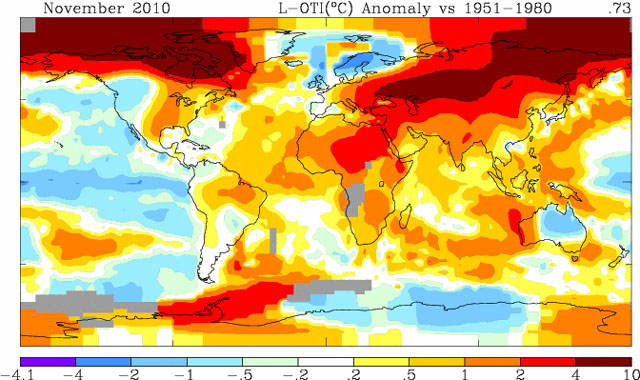
A number of features stand out: for example, the relatively warm Canadian Arctic, the cold anomaly off the west coast of South America - an effect of La Nina - and, relevant to this piece, the very cold UK and Scandinavia.
The UK and Ireland generally enjoy a climate that reflects their geographical position: islands situated off the NW tip of a continent, jutting out into a large warm ocean and right in the path of the prevailing south-westerly wind – the direction from which most of our weather tends to arrive. Steering their way between quasi-permanent features such as the Azores High and the Icelandic Low, the south-westerlies bring warmth and rainfall in equal measure, ensuring our crops are watered and the heating bills are kept down. Or they should. This current outbreak of wintriness, with its plummeting temperatures and paralysing snowfalls, has come via an alternative route - pretty much straight over the top of the world. What's going on?
Regional-scale fluctuations in weather are often controlled, sometimes in a cyclic fashion, by large-scale climatic patterns: thus we have El Nino and La Nina in the Tropical Pacific, with their sometimes major impacts on rainfall – or lack of it. Here in the North Atlantic, things are usually controlled by the strength of the pressure-gradient between the Azores High and the Icelandic Low and by their positions relative to one another. If the gradient between them is strong – as would be the case with intense high pressure over the Azores and deep low pressure over Iceland, a strong west-to-east airflow results and Atlantic storms trundle along one after another, powered by a strong jetstream, bringing mild, wet and often windy conditions to our shores. This weather-pattern is referred to as highly zonal, or mobile. It is the North Atlantic Oscillation (NAO) in its positive phase - the chart below shows a typical example - the red arrows show the mild winds sweeping in from the warm ocean:
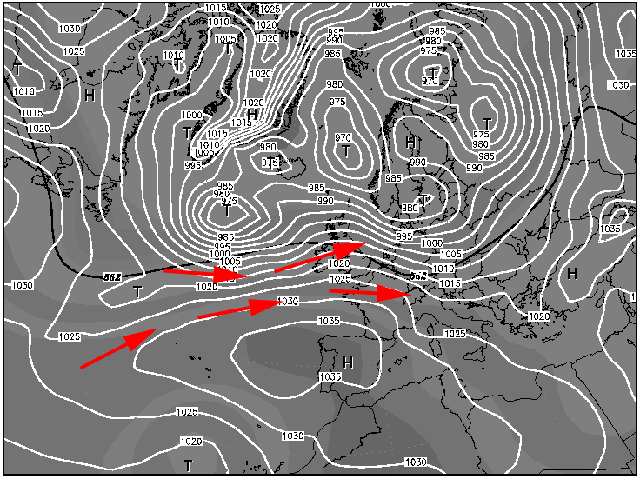
The weaker the pressure-gradient between the Azores High and the Icelandic Low, the more negative the NAO becomes. This results in strongly reduced zonality, to the point that instead a meridional pattern develops – where the jetstream is relatively weak and our weather comes from either the north or the south, bringing (depending on the time of year and direction of airflow) heatwaves or big freezes - as shown in the recent chart below - warm winds are red, cold ones blue:
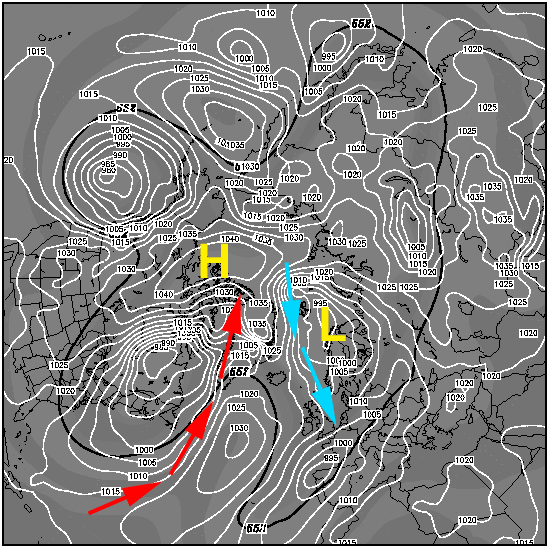
Now, to complicate matters further, a new atmospheric circulation pattern has been identified: the Arctic Dipole, which has become an increasingly-important feature of the Arctic climate during the first decade of the 21st Century. Arctic weather has until recently been driven by the NAO and its close relative, the Arctic Oscillation (AO), both of which broadly produce a circumpolar airflow from west to east. Now, with the Dipole, they have competition and it is having some strange affects on the climate of the Arctic and further afield.
The Arctic Dipole pattern features anomalously high and low pressure systems – they are occurring and persisting where previously they did not. When the Dipole is dominating things, high pressure builds over the American side of the Arctic and low pressure forms on its Eurasian side: this results in an extremely meridional pattern in which winds blow south-to-north through the Bering Strait and into the Arctic from the Pacific, importing extra heat in the process and driving Arctic temperatures further upwards, encouraging further melting of sea-ice well beyond that expected due to anthropogenic greenhouse gas emissions alone. But – ironically – several studies published over the past few years have concluded that the mechanism for its formation was triggered by low sea-ice extent in the first place: it is an example of a positive climate feedback pattern. It works thus: sea-ice has a high albedo – that is, it reflects a lot of solar energy back out to space. Over areas where that ice has melted, the energy is instead absorbed by the open sea-water, warming it. The open water reaches its maximum extent in mid-September: during the Autumn, the research has found, it returns some of that heat back to the lower atmosphere, driving up air temperatures and thereby affecting pressure and atmospheric circulation patterns, which in return go on to cause further excessive summer ice-loss in subsequent years. But these changes are not just affecting the Arctic.
In their updated Arctic Report Card for 2010 (reference 1 at end of page), Overland et al note: “Winter 2009-2010 showed a major new connectivity between Arctic climate and mid-latitude severe weather, compared to the past.” They show what would be considered to be a “normal” pressure-pattern, with anticlockwise circumpolar winds, and then explain how December 2009 saw a complete reversal of this pattern, that essentially eliminated the normal west-to-east jet stream winds. This allowed cold Arctic air to penetrate deeply into some southern regions such as Europe, resulting in very low temperatures and snowy conditions: Northern Eurasia (north of 50° latitude to the Arctic coast) and North America (south of 55° latitude) had negative monthly temperature anomalies of -2°C to -10°C – whilst at the same time, Arctic regions had positive anomalies of +4°C to +12°C. This change in atmospheric circulation has been given the working name of the Warm Arctic-Cold Continents climate pattern. This year a similar pattern appears to have emerged: on November 28th, temperatures in parts of Wales fell to -18C (a November record minimum), but at Kangerlussuaq, inside the Arctic Circle in western Greenland, the minimum was +9C, an amazing 27C warmer.
The graph below shows Arctic sea-ice extent on December 18th 2010. Although ice volume is a better measure, as it demonstrates how much multi-year ice is left (not a lot), extent gives a good idea as to how the seasonal re-freeze is going. It got off to a good start in September 2010, but has since slowed, so that for parts of both November and December it has been the lowest on record.
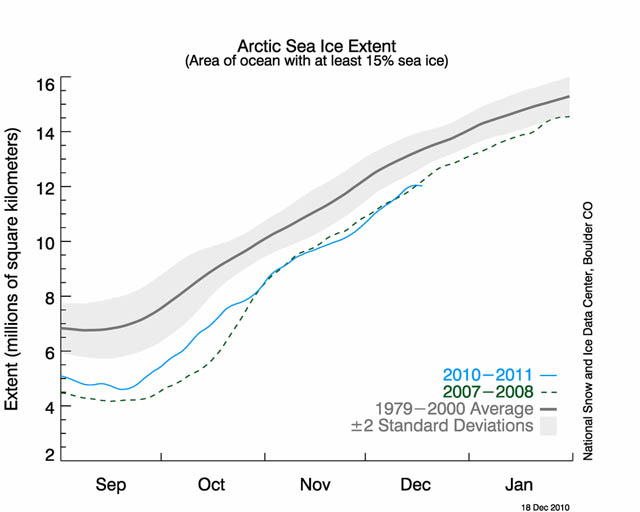
In the case of the Warm Arctic-Cold Continents pattern, one explanation with respect to effects further afield in Europe may be this observed anomalously low late Autumn ice coverage – and accompanying high heat-flow from sea to atmosphere - in the Barents and Kara seas, marginal parts of the Arctic Ocean situated to the north of Scandinavia and Russia (location map below). This potential influence – the “B-K Effect” - has been analysed using a global atmospheric circulation model by Vladimir Petoukhov of the Potsdam Institute for Climate Impact Research and Vladimir Semenov of the Leibniz Institute of Marine Sciences at Kiel University in a study submitted in November 2009 and recently published in the Journal of Geophysical Research (reference 2). Petoukhov and Seminov found that the model responded in a non-linear fashion: rather than resulting in a warming over adjacent continents as might have been expected, a strong regional cooling was generated within a certain range of sea-ice cover. In the abstract, they go so far as to state: “Here we show that anomalous decrease of wintertime sea-ice concentration in the Barents-Kara (B-K) seas could bring about extreme cold events like winter 2005-2006.” The paper, and indeed the whole subject of cold European winters and how they relate to the overall global climate, has been the subject of much lively discussion, in the context of that particular winter and others past and present. Writing on the Realclimate blog on December 14th 2010 (reference 3), Rasmus Benestad of the Norwegian Meteorological Institute noted that, while Petoukhov and Seminov's findings sound plausible, things may not be so straightforward. With respect to using global circulation models to determine regional effects, he commented: “There is a limit to what they are able to describe in terms of local regional details, and it it reasonable to ask whether the response to changes in regional sea-ice cover is beyond the limitation of the global model.”
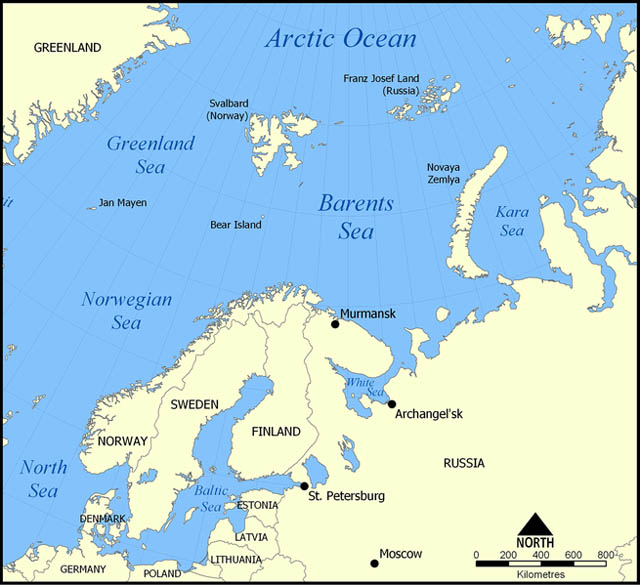
However, talking about non-straightforwardness, it is also apparent that, whilst important, the NAO alone is not an absolute way to determine how a particular cold winter compares to others. NAO data are available online from the National Center for Atmospheric Research at Boulder, Colorado (reference 4). The data show that the cold winter of 2009-10 featured the lowest ever December-February (DJF) NAO index of -5.1. However, whilst 2009-10 caused major problems in parts of the UK, it was not as cold as the historic 1962-63 winter, with a higher NAO index of -4.0 but, in the UK, having a Central England Temperature (CET) of -0.3C for the DJF period. The CET for the equivalent period in 2009-10 was 2.4C. If the NAO was the absolute control-mechanism with respect to the severity of our winters, then by rights 2009-10 should have been colder than 1962-3.
So: has recent research found an added influence on our European winters? The Arctic has become an area of substantial positive temperature anomalies: this has been directly observed. The sea-ice anomalies and lower atmosphere heating over open Arctic water in Autumn have been directly observed. The relatively new Arctic pressure and atmospheric circulation patterns have been directly observed. Papers have been published citing evidence for these features to have a potential effect on the climate further afield, including an increased severity of European winters. Although climate trends are multidecadal affairs and the research discussed above is relatively recent, the influence of open sea water in the Arctic, where at one time there was extensive sea-ice, is clearly one to watch in the coming years. As with most matters of science, the truth will come out in the wash in due course. This may not be the black-or-white conclusion that policymakers seem to expect these days, but that's how the world works: they might like to stop and reflect that the decisions that led to the Allies' victory in World War 2 were not made in the light of absolute certainty of outcomes.
Acknowledgments:
Thanks to James Overland of NOAA for sending me reprints of papers discussing the matters described above, and to the Climate Rapid Response Team at http://www.climaterapidresponse.org/ for their useful help with my research.
References & further reading:
1) http://www.arctic.noaa.gov/reportcard/atmosphere.html
2) Petoukhov, V., and V. Semenov (2010): A link between reduced Barents-Kara sea ice and cold winter extremes over northern continents. J. Geophys. Res.-Atmos., ISSN 0148-0227.
3) http://www.realclimate.org/index.php/archives/2010/12/cold-winter-in-a-world-of-warming/
4) http://www.cgd.ucar.edu/cas/jhurrell/indices.data.html#naostatseas
Budikova, D. (2009): Role of Arctic sea ice in global atmospheric circulation: A review. Global Planet. Change, 68(3), 149–163.
Honda, M., J. Inoue, and S. Yamane (2009): Influence of low Arctic sea-ice minima on anomalously cold Eurasian winters. Geophys. Res. Lett., 36, L08707, doi:10.1029/2008GL037079.
Overland, J.E., and M. Wang (2010): Large-scale atmospheric circulation changes associated with the recent loss of Arctic sea ice. Tellus, 62A, 1–9.